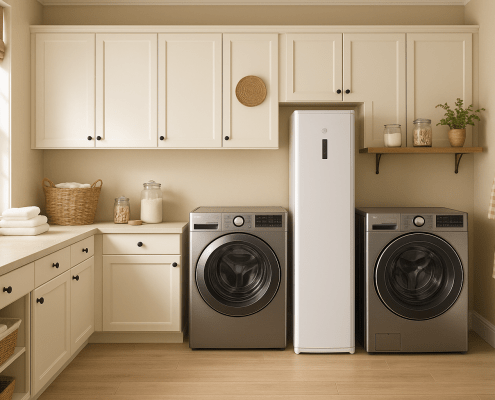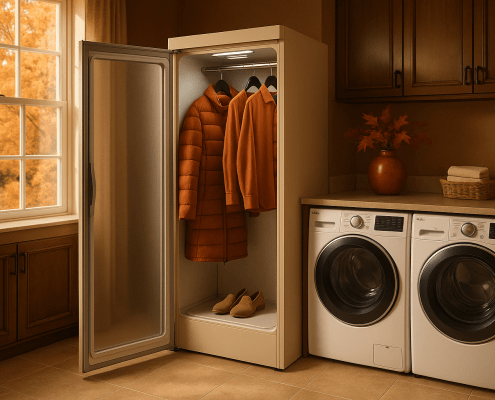Repairing a Laundry Steam Closet That’s Not Recognizing Clothing
Steven E / Thursday July 3, 2025
Laundry steam closets are one of those modern conveniences that feel like magic, pop your shirt inside, press a button, and a few minutes later it’s wrinkle-free, sanitized, and ready to wear. But when your steam closet stops recognizing clothing, that magic suddenly disappears.
You’re not alone, this is one of the more common frustrations owners run into, and thankfully, it’s something you can fix yourself with the right approach. Stick around, because by the end of this article, you’ll know exactly how.
The information in this article may not apply to your specific appliance model. We recommend consulting your manufacturer’s documentation or contact us with any questions.
How Steam Closets Detect Clothing
Before you grab your tools, it helps to understand how a steam closet knows clothing is inside in the first place. These units generally use a combination of:
- Weight sensors in the hanger bar or the floor plate
- Infrared (IR) or optical sensors to detect the presence and shape of garments
- Internal software that determines if the load is sufficient to run
When these sensors don’t get the right signal, because of dirt, damage, misalignment, or a faulty part, the steam closet may display an error or refuse to start.
Reasons Your Steam Closet Won’t Recognize Clothing
There are a few usual suspects when your closet refuses to acknowledge what’s hanging inside.
- Dust, lint, or residue on the optical sensors
- Misaligned or bent hanger rods or clips
- Disconnected or loose sensor wiring
- Defective weight sensor or IR sensor
- Calibration drift in the control board
Fortunately, each of these is something you can check, clean, and repair yourself.
Step 1: Rule Out Clothing Issues
Start with the easiest check: What are you putting inside the closet?
- Make sure clothing is hung on the provided or compatible hangers.
- Don’t overload the unit; check your manual for maximum capacity.
- Ensure garments aren’t bunched up or covering the sensors.
- Verify that the clothing weight and type are detectable by the closet’s sensors (some extremely lightweight fabrics may not register).
If your setup looks good and the problem persists, move on to the next step.
Step 2: Clean the Sensors
Sensors are precision devices, and they don’t work well when covered in lint, dust, or cleaning residue.
- Turn off and unplug the unit.
- Open the door and locate the sensors (usually near the hanger bar and at the sides of the cabinet).
- Wipe down the hanger bar and any visible sensor lenses or windows.
- Dip a cotton swab in alcohol and gently clean around the sensors.
- Let everything dry for a few minutes before plugging back in.
Step 3: Check for Loose or Disconnected Wires
Inside your steam closet, wiring harnesses connect the sensors to the control board. If one comes loose, the system may not see any clothing present.
- Unplug the unit and carefully open the back or bottom access panel.
- Check all sensor wiring harnesses and press them firmly into place.
- Inspect wires for cuts or worn insulation.
Step 4: Test the Weight Sensor
Most steam closets have a weight sensor that detects when there’s something hanging on the bar. If the sensor is faulty, the system will assume nothing is there.
- Unplug the unit and access the weight sensor (usually at the ends of the hanger bar).
- Disconnect the sensor wiring and set your multimeter to the continuity or ohms setting.
- Hang weight on the bar and watch the reading. It should change when weight is applied.
- If there’s no change, the sensor is bad and needs to be replaced.
Replacement weight sensors are generally easy to install; simply unscrew the old one, plug in the new one, and reassemble.
Step 5: Check the Infrared or Optical Sensors
These sensors emit and receive light to “see” clothing. If they fail, the closet thinks it’s empty.
What to Look For:
- Obvious cracks or scratches on the sensor lens.
- Burnt or blackened sensor elements.
- No change in multimeter reading when something is waved in front of the sensor (if you have access to the wiring).
Many IR sensors are replaceable as a module, pop out the faulty sensor and install the replacement using the same connector and mounting screws.
Step 6: Recalibrate the System
If all hardware looks good, the system itself may need to be recalibrated. Over time, the control board can lose its baseline reference for detecting weight or distance.
How to Recalibrate:
- Unplug the unit and wait for a full minute.
- Plug back in while holding down the “Start” or “Power” button (refer to your manual for specific key combinations).
- The unit should enter calibration mode and reset its baseline.
- Run a test cycle with clothing loaded to confirm.
If the problem persists even after recalibration, the control board itself may need replacement.
Where To Find Us
If you need any replacement parts for your appliances, you can enter your model number at AppliancePartsPros.com to locate and order them quickly. Most orders arrive in just two business days, and we have tons of great information in our repair help section and YouTube videos to help you troubleshoot.
Stay connected with the latest DIY tips, tutorial videos, and repair guides by following us on Facebook, Instagram, and Twitter. We love hearing about your repair stories and successes. If you need more help or want personalized guidance, feel free to reach out. We’re ready to help you take on your next project with confidence!
With nearly a decade of experience in providing top-notch customer service regarding appliance parts and repair, Steven enjoys sharing practical advice, troubleshooting tips, and interesting information to help readers stay informed.





